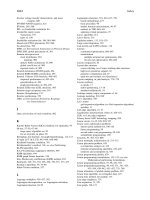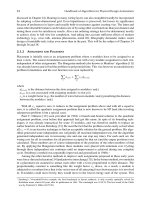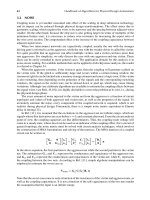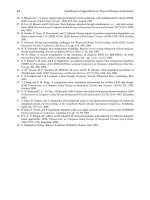Handbook of Materials for Product Design Part 15 pdf
Bạn đang xem bản rút gọn của tài liệu. Xem và tải ngay bản đầy đủ của tài liệu tại đây (1.47 MB, 80 trang )
12.48 Chapter 12
TABLE 12.13 Surface Preparation for Metals (Continued)
12Petrie Page 48 Wednesday, May 23, 2001 10:43 AM
Plastics and Elastomers as Adhesives 12.49
TABLE 12.13 Surface Preparation for Metals (Continued)
12Petrie Page 49 Wednesday, May 23, 2001 10:43 AM
12.50 Chapter 12
ously described are all applicable to metallic surfaces, but the
processes listed in Table 12.13 have been specifically found to provide
reproducible structural bonds and fit easily into the bonding opera-
tion. The metals most commonly used in bonded structures and their
respective surface treatments are described more fully in the following
sections.
Aluminum and aluminum alloys . The effects of various aluminum sur-
face treatments have been studied extensively. The most widely used
process for high-strength, environment-resistant adhesive joints is the
sodium dichromate-sulfuric acid etch, developed by Forest Product
Laboratories and known as the FPL etch process. Abrasion or solvent
degreasing treatments result in lower bond strengths, but these sim-
pler processes are more easily placed into production. Table 12.14
qualitatively lists the bond strengths which can be realized with vari-
ous aluminum treatments.
Copper and copper alloys. Surface preparation of copper alloys is nec-
essary to remove weak oxide layers attached to the copper surface.
This oxide layer is especially troublesome, because it forms very rap-
idly. Copper specimens must be bonded or primed as quickly as possi-
ble after surface preparation. Copper also has a tendency to form
brittle surface compounds when used with certain adhesives that are
corrosive to copper.
One of the better surface treatments for copper, utilizing a commer-
cial product named Ebonol C (Enthane, Inc., New Haven, CT), does
not remove the oxide layer but creates a deeper and stronger oxide for-
mation. This process, called black oxide, is commonly used when bond-
TABLE
12
.
13 S
ur
f
ace
P
repara
ti
on
f
or
M
e
t
as
(C
on
ti
nue
d)
12Petrie Page 50 Wednesday, May 23, 2001 10:43 AM
Plastics and Elastomers as Adhesives 12.51
ing requires elevated temperatures, for example, for laminating
copper foil. Chromate conversion coatings are also used for high-
strength copper joints.
Magnesium and magnesium alloys. Magnesium is one of the lightest
metals. The surface is very sensitive to corrosion, and chemical prod-
ucts are often formed at the adhesive–metal interface during bonding.
Preferred surface preparations for magnesium develop a strong sur-
face coating to prevent corrosion. Proprietary methods of producing
such coatings have been developed by magnesium producers.
Steel and stainless steel. Steels are generally easy to bond, provided
that all rust, scale, and organic contaminants are removed. This may
be accomplished easily by a combination of mechanical abrasion and
solvent cleaning. Table 12.15 shows the effect of various surface treat-
ments on the tensile shear strength of steel joints bonded with a vinyl-
phenolic adhesive.
Prepared steel surfaces are easily oxidized. Once processed, they
should be kept free of moisture and primed or bonded within 4 hr.
Stainless surfaces are not as sensitive to oxidation as carbon steels,
and a slightly longer time between surface preparation and bonding is
acceptable.
TABLE 12.14 Surface Treatment for Adhesive Bonding Aluminum (from Ref. 25)
Surface treatment Type of bond
Solvent wipe (MEK, MIBK, trichloroethylene) Low to medium strength
Abrasion of surface, plus solvent wipe (sandblasting,
coarse sandpaper, etc.)
Medium to high strength
Hot-vapor degrease (trichloroethylene) Medium strength
Abrasion of surface, plus vapor degrease Medium to high strength
Alodine treatment Low strength
Anodize Medium strength
Caustic etch
*
High strength
Chromic acid etch (sodium dichromate-surface acid)
†
*
A good caustic etch is Oakite 164 (Oakite Products, Inc., 19 Rector Street, New York).
†
Recommended pretreatment for aluminum to achieve maximum bond strength and weatherability:
1. Degrease in hot trichloroethylene vapor (160°F).
2. Dip in the following chromic acid solution for 10 min at 160°F:
Sodium dischromate (Na
2
Cr
2
)H ⋅ 2H
2
O 1 part/wt
Cone, sulfuric acid (sp. gr. 1.86) 10 parts/wt.
Distilled water 30 parts/wt.
3. Rinse thoroughly in cold, running, distilled, or deionized water.
4. Air dry for 30 min, followed by 10 min at 150°F.
12Petrie Page 51 Wednesday, May 23, 2001 10:43 AM
12.52 Chapter 12
Titanium alloys. Because of the usual use of titanium at high tempera-
tures, most surface preparations are directed at improving the ther-
mal resistance of titanium joints. Like magnesium, titanium can also
react with the adhesive during cure and create a weak boundary layer.
12.3.7.2 Plastic adherends. Many plastics and plastic composites can
be treated by simple mechanical abrasion or alkaline cleaning to re-
move surface contaminants. In some cases, it is necessary that the
polymeric surface be physically or chemically modified to achieve ac-
ceptable bonding. This applies particularly to crystalline thermoplas-
tics such as the polyolefins, linear polyesters, and fluorocarbons.
Methods used to improve the bonding characteristics of these surfaces
include:
1. Oxidation via chemical treatment or flame treatment
2. Electrical discharge to leave a more reactive surface
3. Ionized inert gas, which strengthens the surface by cross-linking
and leaves it more reactive
4. Metal-ion treatment
Table 12.16 lists common recommended surface treatments for plas-
tic adherends. These treatments are necessary when plastics are to be
TABLE 12.15 Effect of Pretreatment on the Shear Strength of Steel Joints Bonded
with a Polyvinyl Formal Phenolic Adhesive (from Ref. 26)
Martensitic steel Austenitic steel Mild steel
Pretreatment MC MCMC
Grit blast + vapor degreasing 5120 13.1 4100 4.7 4360 7.8
Vapor blast + vapor degreasing 6150 5.6 4940 7.1 4800 5.9
The following treatments were preceded by vapor degreasing:
Cleaning in metasilicate solution 4360 5.7 3550 7.8 4540 6.1
Acid-dichromate etch 5780 5.8 2150 22.5 4070 4.0
Vapor blast + acid dichromate
etch
6180 4.1
Hydrochloric acid etch + phos-
phoric acid etch
3700 17.9 950 20.2 3090 20.7
Nitric/hydrofluoric acid etch 6570 7.5 3210 15.2 4050 8.4
M = mean failing load, lb/in
2
. C = coefficient of variation, %.
12Petrie Page 52 Wednesday, May 23, 2001 10:43 AM
Plastics and Elastomers as Adhesives 12.53
joined with adhesives. Solvent and heat welding are other methods of
fastening plastics that do not require chemical alteration of the sur-
face. Welding procedures were discussed in the previous chapter.
As with metallic substrates, the effects of plastic surface treatments
decrease with time. It is necessary to prime or bond soon after the sur-
faces are treated. Listed below are some common plastic materials
that require special physical or chemical treatments to achieve ade-
quate surfaces for adhesive bonding.
Fluorocarbons. Fluorocarbons such as polytetrafluoroethylene (TFE),
polyfluoroethylene propylene (FEP), polychlorotrifluoroethylene (CFE),
and polymonochlorotrifluoroethylene (Kel-F) are notoriously difficult
to bond because of their low surface tension. However, epoxy and poly-
urethane adhesives offer moderate strength if the fluorocarbon is
treated prior to bonding.
The fluorocarbon surface may be made more wettable by exposing it
for a brief moment to a hot flame to oxidize the surface. The most sat-
isfactory surface treatment is achieved by immersing the plastic in a
bath consisting of sodium-naphthalene dispersion in tetrahydrofuran.
This process is believed to remove fluorine atoms, leaving a carbonized
surface that can be wet easily. Fluorocarbon films pretreated for adhe-
sive bonding are available from most suppliers. A formulation and de-
scription of the sodium-naphthalene process may be found in Table
12.16. Commercial chemical products for etching fluorocarbons are
also listed.
Polyethylene terephthalate (mylar). A medium-strength bond can be ob-
tained with polyethylene terephthalate plastics and films by abrasion
and solvent cleaning. However, a stronger bond can be achieved by im-
mersing the surface in a warm solution of sodium hydroxide or in an
alkaline cleaning solution for 2 to 10 min.
Polyolefins, polyformaldehyde, polyether. These materials can be effec-
tively bonded only if the surface is first located. Polyethylene and
polypropylene can be prepared for bonding by holding the flame of an
oxyacetylene torch over the plastic until it becomes glossy, or else by
heating the surface momentarily with a blast of hot air. It is important
not to overheat the plastic, thereby causing deformation. The treated
plastic must be bonded as quickly as possible after surface prepara-
tion.
Polyolefins, such as polyethylene, polypropylene, and polymethyl-
pentene, as well as polyformaldehyde and polyether, may be more ef-
fectively treated with a sodium dichromate-sulfuric acid solution. This
treatment oxidizes the surface, allowing better wetting. Activated gas
plasma treatment, described in the general section on surface treat-
ments is also an effective treatment for these plastics. Table 12.17
12Petrie Page 53 Wednesday, May 23, 2001 10:43 AM
12.54 Chapter 12
TABLE 12.16 Surface Preparations for Plastics
12Petrie Page 54 Wednesday, May 23, 2001 10:43 AM
Plastics and Elastomers as Adhesives 12.55
TABLE 12.16 Surface Preparations for Plastics (Continued)
12Petrie Page 55 Wednesday, May 23, 2001 10:43 AM
12.56 Chapter 12
TABLE 12.16 Surface Preparations for Plastics (Continued)
12Petrie Page 56 Wednesday, May 23, 2001 10:43 AM
Plastics and Elastomers as Adhesives 12.57
TABLE 12.16 Surface Preparations for Plastics (Continued)
12Petrie Page 57 Wednesday, May 23, 2001 10:43 AM
12.58 Chapter 12
shows the tensile-shear strength of bonded polyethylene pretreated by
these various methods.
12.3.7.3 Elastomeric adherends. Vulcanized-rubber joints are often
contaminated with mold release and plasticizers or extenders that can
migrate to the surface. As shown in Table 12.18, solvent washing and
abrading are common treatments for most elastomers, but chemical
treatment may be required for maximum properties. Synthetic and
natural rubbers may require cyclizing with concentrated sulfuric acid
until hairline fractures are evident on the surface.
12.3.7.4 Other adherends. Table 12.19 provides surface treatments
for a variety of materials not covered in the preceding tables. Bonding
to painted or plated parts requires special consideration. The result-
ing adhesive bond is only as strong as the adhesion of the paint or
plating to the base material.
TABLE
12
.
16 S
ur
f
ace
P
repara
ti
ons
f
or
P
as
ti
cs
(C
on
ti
nue
d)
12Petrie Page 58 Wednesday, May 23, 2001 10:43 AM
12.59
TABLE 12.17 Effects of Surface Treatments on Bonding to Polyethylene with Various Types of Adhesives (from Ref. 27)
12Petrie Page 59 Wednesday, May 23, 2001 10:43 AM
12.60 Chapter 12
12.4 Types of Adhesives
12.4.1 Adhesive Composition
Modern-day adhesives are often fairly complex formulations of compo-
nents that perform specialty functions. The adhesive base or binder is
TABLE
12
.
18 S
ur
f
ace
P
repara
ti
on
f
or
E
as
t
omers
12Petrie Page 60 Wednesday, May 23, 2001 10:43 AM
Plastics and Elastomers as Adhesives 12.61
the primary component of an adhesive. The binder is generally the
resinous component from which the name of the adhesive is derived.
For example, an epoxy adhesive may have many components, but the
primary material is epoxy resin.
TABLE
12
.
18 S
ur
f
ace
P
repara
ti
on
f
or
E
as
t
omers
(C
on
ti
nue
d)
TABLE 12.19 Surface Preparations for Materials Other than Metals,
Plastics, and Elastomers
12Petrie Page 61 Wednesday, May 23, 2001 10:43 AM
12.62 Chapter 12
A hardener is a substance added to an adhesive formulation to ini-
tiate the curing reaction and take part in it. Two-component adhesive
systems have one component, which is the base, and a second compo-
nent, which is the hardener. Upon mixing, a chemical reaction ensues
that causes the adhesive to solidify. A catalyst is sometimes incorpo-
TABLE
12
.
19 S
ur
f
ace
P
repara
ti
ons
f
or
M
a
t
er
i
as
Oth
er
th
an
M
e
t
a s,
Plastics, and Elastomers (Continued)
12Petrie Page 62 Wednesday, May 23, 2001 10:43 AM
Plastics and Elastomers as Adhesives 12.63
rated into an adhesive formulation to speed the reaction between base
and hardener.
Solvents are sometimes needed to lower viscosity or to disperse the
adhesive to a spreadable consistency. Often, a mixture of solvents is
required to achieve the desired properties.
A reactive ingredient added to an adhesive to reduce the concentra-
tion of binder is called a diluent. Diluents are principally used to lower
viscosity and modify processing conditions of some adhesives. Diluents
react with the binder during cure, become part of the product, and do
not evaporate as does a solvent.
Fillers are generally inorganic particulates added to the adhesive to
improve working properties, strength, permanence, or other qualities.
Fillers are also used to reduce material cost. By selective use of fillers,
the properties of an adhesive can be changed tremendously. Thermal
expansion, electrical and thermal conduction, shrinkage, viscosity,
and thermal resistance are only a few properties that can be modified
by use of selective fillers.
A carrier or reinforcement is usually a thin fabric used to support a
semicured (B-staged) adhesive to provide a product that can be used
as a tape or film. The carrier can also serve as a spacer between the
adherends and reinforcement for the adhesive.
Adhesives can be broadly classified as being thermoplastic, thermo-
setting, elastomeric, or an alloy blend. These four adhesive classifica-
tions can be further subdivided by specific chemical composition as
described in Tables 12.20 through 12.23. The types of resins that go
into the thermosetting and alloy adhesive classes are noted for high
strength, creep resistance, and resistance to environments such as
heat, moisture, solvents, and oils. Their physical properties are well
suited for structural-adhesive applications.
Elastomeric and thermoplastic adhesive classes are not used in ap-
plications requiring continuous load, because of their tendency to
creep under stress. They are also degraded by many common service
environments. These adhesives find greatest use in low-strength ap-
plications such as pressure-sensitive tape, sealants, and hot melt
products.
12.4.2 Structural Adhesives
12.4.2.1 Epoxy.
Epoxy adhesives offer a high degree of adhesion to all
substrates except some untreated plastics and elastomers. Cured ep-
oxies have thermosetting molecular structures. They exhibit excellent
tensile-shear strength but poor peel strength unless modified with a
more resilient polymer. Epoxy adhesives offer excellent resistance to
12Petrie Page 63 Wednesday, May 23, 2001 10:43 AM
12.64
TABLE 12.20 Thermosetting Adhesives
Adhesive Description
Curing
method
Special
characteristics
Usual
adherends
Price
range
Cyanoacrylate One-part liquid Rapidly at RT
in absence of air
Fast setting; good bond strength; low viscosity; high
cost; poor heat and shock resistance; will not bond to
acidic surfaces
Metals, plastics,
glass
Very high
Polyester Two-part liquid or paste RT or higher Resistant to chemicals, moisture, heat, weathering;
good electrical properties; wide range of strengths;
some resins do not fully cure in presence of air; isocy-
anate-cured system bonds well to many plastic films
Metals, foils,
plastics, plastic
laminates, glass
Low–
med
Urea formaldehyde Usually supplied as two-part
resin and hardening agent;
extenders and fillers used
Under pressure Not as durable as others but suitable for fair range of
service conditions; generally low cost and ease of
application and cure; pot life limited to 1 to 24 hr
Plywood Low
Melamine
formaldehyde
Powder to be mixed with
hardening agent
Heat and pres-
sure
Equivalent in durability and water resistance (includ-
ing boiling water) to phenolics and resorcinols; often
combined with ureas to lower cost; higher service
temp than ureas
Plywood, other
wood products
Med
Resorcinol and
phenol-resorcinol
formaldehyde
Usually alcohol-water solutions
to which formaldehyde must
be added
RT or higher
with moderate
pressure
Suitable for exterior use; unaffected by boiling water,
mold, fungus, grease, oil, most solvents; bond
strength equals or betters strength of wood; do not
bond directly to metal
Wood, plastics,
paper, fiber-
board,
plywood
Med
12Petrie Page 64 Wednesday, May 23, 2001 10:43 AM
12.65
Epoxy Two-part liquid or paste; one-part
liquid, paste or solid; solutions
RT or higher Most versatile adhesive available; excellent tensile-
shear strength; poor peel strength; excellent resis-
tance to moisture and solvents; low cure shrinkage;
variety of curing agents/hardeners results in many
variations
Metals, plastic,
glass,
rubber, wood,
ceramics
Med
Polyimide Supported film, solvent solution High temp Excellent thermal and oxidation resistance; suitable for
continuous use at 550°F and short-term use to 900·F;
expensive
Metals, metal foil,
honeycomb core
Very high
Polybenzimidazole Supported film Long, high-temp
cure
Good strength at high temperatures; suitable for con-
tinuous use at 450°F and short-term use at 1000°F;
volatiles released during cure; deteriorates at high
temperatures on exposure to air; expensive
Metals, metal foil,
honeycomb core
Very high
Acrylic Two-part liquid or paste RT Excellent bond to many plastics, good weather resis-
tance, fast cure, catalyst can be used as a substrate
primer; poor peel and impact strength
Metals, many
plastics, wood
Very high
Acrylate
acid diester
One-part liquid or paste RT or higher in
absence of air
Chemically blocked, anaerobic type; excellent wetting
ability; useful temperature range of –65 to 300°F;
withstands rapid thermal cycling; high-tensile-
strength grade requires cure at 250°F, cures in min-
utes at 280°F
Metals, plastics,
glass, wood
Very high
TABLE
12.20 Thermosetting Adhesives (Continued)
12Petrie Page 65 Wednesday, May 23, 2001 10:43 AM
12.66
TABLE 12.21 Thermoplastic Adhesives
Adhesive Description
Curing
method
Special
characteristics
Usual
adherends
Price
range
Cellulose
acetate,
cellulose
acetate
butyrate
Solvent solutions Solvent evaporation Water-clear, more heat resistant but less water
resistant than cellulose nitrate; cellulose acetate
butyrate has better heat and water resistance
than cellulose acetate and is compatible with a
wider range of plasticizers
Plastics, leather, paper,
wood, glass, fabrics
Low
Cellulose
nitrate
Solvent solutions Evaporation of sol-
vent
Tough, develops strength rapidly, water resistant;
bonds to many surfaces; discolors in sunlight;
dried adhesive is flammable
Glass, metal, cloth, plastics Low
Polyvinyl
acetate
Solvent solutions and water emul-
sions, plasticized or unplasti-
cized, often containing fillers
and pigments; also dried film
that is light stable, water-white,
transparent
On evaporation of sol-
vent or water; film
by heat and pres-
sure
Bond strength of several thousand lb/in.
2
but not
under continuous loading; the most versatile in
terms of formulations and uses; tasteless, odor-
less; good resistance to oil, grease, acid; fair water
resistance
Emulsions particularly use-
ful with porous materials
like wood and paper; solu-
tions used with plastic
films, mica, glass, metal,
ceramics
Low
Vinyl
vinylidene
Solutions in solvents like methyl
ethyl ketone
Evaporation of sol-
vent
Tough, strong, transparent, and colorless; resistant
to hydrocarbon solvents, greases, oils
Particularly useful with tex-
tiles; also porous materials,
plastics
Med
12Petrie Page 66 Wednesday, May 23, 2001 10:43 AM
12.67
Polyvinyl
acetals
Solvent solutions, film, and solids Evaporation of sol-
vent; film and solid
by heat and pres-
sure
Flexible bond; modified with phenolics for struc-
tural use; good resistance to chemicals and oils;
includes polyvinyl formal and polyvinyl butyral
types
Metals, mica, glass, rubber,
wood, paper
Med
Polyvinyl
alcohol
Water solutions, often extended
with starch or clay
Evaporation of water Odorless, tasteless, and fungus-resistant (if
desired); excellent resistance to grease and oils;
water soluble
Porous materials such as
fiberboard, paper, cloth
Low
Polyamide Solid hot-melt, film, solvent solu-
tions
Heat and pressure Good film flexibility; resistant to oil and water; used
for heat-sealing compounds
Metals, paper, plastic films Med
Acrylic Solvent solutions, emulsions, and
mixtures requiring added cata-
lysts
Evaporation of sol-
vent; RT or ele-
vated temp (two-
part)
Good low-temperature bonds; poor heat resistance;
excellent resistance to ultraviolet; clear; colorless
Glass, metals, paper, textiles,
metallic foils, plastics
Med
Phenoxy Solvent solutions, film, solid hot-
melt
Heat and pressure Retains high strength from 40 to 180°F; resists
creep up to 180°F; suitable for structural use
Metals, wood, paper, plastic
film
Med
TABLE
12.21 Thermoplastic Adhesives (Continued)
12Petrie Page 67 Wednesday, May 23, 2001 10:43 AM
12.68
TABLE 12.22 Elastomeric Adhesives
Adhesive Description
Curing
method
Special
characteristics
Usual
adherends
Price
range
Natural
rubber
Solvent solutions, latexes, and
vulcanizing type
Solvent evapora-
tion, vulcaniz-
ing type by heat
or RT (two-part)
Excellent tack, good strength; shear strength 30–180
lb/in.
2
; peel strength 0.56 lb/in. width; surface can be
tack-free to touch and yet bond to similarly coated
surface
Natural rubber, maso-
nite, wood, felt, fabric,
paper, metal
Med
Reclaimed
rubber
Solvent solutions, some water dis-
persions; most are black, some
gray and red
Evaporation of
solvent
Low cost, widely used; peel strength higher than natu-
ral rubber; failure occurs under relatively low con-
stant loads
Rubber, sponge rubber,
fabric, leather, wood,
metal, painted metal,
building materials
Low
Butyl Solvent system, latex Solvent evapora-
tion, chemical
cross-linking
with curing
agents and heat
Low permeability to gases, good resistance to water
and chemicals, poor resistance to oils, low strength
Rubber, metals Med
Polyisobutylene Solvent solution Evaporation of
solvent
Sticky, low-strength bonds; copolymers can be cured to
improve adhesion, environmental resistance, and
elasticity; good aging; poor thermal resistance;
attacked by solvents
Plastic film, rubber,
metal foil, paper
Low
Nitrile Latexes and solvent solutions
compounded with resins, metal-
lic oxides, fillers, etc.
Evaporation of
solvent and/or
heat and pres-
sure
Most versatile rubber adhesive; superior resistance to
oil and hydrocarbon solvents; inferior in tack range,
but most dry tack-free, an advantage in precoated
assemblies; shear strength of 150–2000 lb/in.
2
, higher
than neoprene, if cured
Rubber (particularly
nitrile), metal, vinyl
plastics
Med
12Petrie Page 68 Wednesday, May 23, 2001 10:43 AM
12.69
Styrene
butadiene
Solvent solutions and latexes;
because tack is low, rubber is
compounded with tackifiers and
plasticizing oils
Evaporation of
solvent
Usually better aging properties than natural or
reclaimed; low dead load strength; bond strength sim-
ilar to reclaimed; useful temp range from –40 to
160°F
Fabrics, foils, plastic
film laminates, rubber
and sponge rubber,
wood
Low
Polyurethane Two-part liquid or paste RT or higher Excellent tensile-shear strength from –400 to 200°F;
poor resistance to moisture before and after cure;
good adhesion to plastics
Plastics, metals, rubber Med
Polysulfide Two-part liquid or paste RT or higher Resistant to wide range of solvents, oils, and greases;
good gas impermeability; resistant to weather, sun-
light, ozone; retains flexibility over wide temperature
range; not suitable for permanent load-bearing appli-
cations
Metals, wood, plastics High
Silicone Solvent solution; heat or RT cur-
ing and pressure sensitive; and
RT vulcanizing pastes
Solvent evapora-
tion, RT or ele-
vated temp
Of primary interest is pressure-sensitive type used for
tape; high strengths for other forms are reported from
–100 to 500°F; limited service to 700°F; excellent
dielectric properties
Metals; glass; paper;
plastics and rubber,
including silicone and
butyl rubber and fluo-
rocarbons
High–
very
high
Neoprene Latexes and solvent solutions,
often compounded with resins,
metallic oxides, fillers, etc.
Evaporation of
solvent
Superior to other rubber adhesives in most
respects—quickness; strength; max temp (to 200°F,
sometimes 350°F); aging; resistant to light, weather-
ing, mild acids, oils
Metals, leather, fabric,
plastics, rubber (par-
ticularly neoprene),
wood, building materi-
als
Med
TABLE
12.22 Elastomeric Adhesives (Continued)
12Petrie Page 69 Wednesday, May 23, 2001 10:43 AM
12.70
TABLE 12.23 Alloy Adhesives
Adhesive Description
Curing
method
Special
characteristics
Usual
adherends
Price
range
Epoxy-
phenolic
Two-part paste,
supported film
Heat and
pressure
Good properties at moderate cures; volatiles released
during cure; retains 50% of bond strength at 500°F;
limited shelf life; low peel strength and shock resis-
tance
Metals, honeycomb core, plastic laminates,
ceramics
Med
Epoxy-
polysulfide
Two-part liquid or
paste
RT or
higher
Useful temperature range –70 to 200°F, greater resis-
tance to impact, higher elongation, and less brittle-
ness than epoxies
Metals, plastic, wood, concrete Med
Epoxy-
nylon
Solvent solutions,
supported and
unsupported film
Heat and
pressure
Excellent tensile-shear strength at cryogenic tempera-
ture; useful temperature range –423 to 180°F; limited
shelf life
Metals, honeycomb core, plastics Med
Nitrile-
phenolic
Solvent solutions,
unsupported and
supported film
Heat and
pressure
Excellent shear strength; good peel strength; superior to
vinyl and neoprene—phenolics; good adhesion
Metals, plastics, glass, rubber Med
Neoprene-
phenolic
Solvent solutions,
unsupported and
supported film
Heat and
pressure
Good bonds to a variety of substrates; useful temp range
–70 to 200°F, excellent fatigue and impact strength
Metals, glass, plastics Med
Vinyl-
phenolic
Solvent solutions and
emulsions, tape,
liquid, and coreact-
ing powder
Heat and
pressure
Good shear and peel strength; good heat resistance;
good resistance to weathering, humidity, oil, water,
and solvents; vinyl formal and vinyl butyral forms
available, vinyl formal–phenolic is strongest
Metals, paper, honeycomb core Low
–med
12Petrie Page 70 Wednesday, May 23, 2001 10:43 AM
Plastics and Elastomers as Adhesives 12.71
oil, moisture, and many solvents. Low cure shrinkage and high resis-
tance to creep under prolonged stress are characteristic of epoxy res-
ins.
Epoxy adhesives are commercially available as liquids, pastes, and
semicured (B-staged) film and solids. Epoxy adhesives are generally
supplied as a 100% solids (nonsolvent) formulation, but some spray-
able epoxy adhesives are available in solvent systems. Epoxy resins
have no evolution of volatiles during cure and are useful in gap-filling
applications.
Depending on the type of curing agent, epoxy adhesives can cure at
room or elevated temperatures. Higher strengths and better heat re-
sistance are usually obtained with the heat-curing types. Room-tem-
perature-curing epoxies can harden in as little as 1 min at room
temperature, but most systems require from 18 to 72 hr. The curing
time is greatly temperature-dependent, as shown in Fig. 12.27.
Epoxy resins are the most versatile of structural adhesives, because
they can be cured and co-reacted with many different resins to provide
widely varying properties. Table 12.24 describes the influence of cur-
ing agents on the bond strength of epoxy to various adherends. The
type of epoxy resin used in most adhesives is derived from the reaction
of bisphenol A and epichlorohydrin. This resin can be cured with
amines or polyamides for room-temperature-setting systems; anhy-
drides for elevated-temperature cure; or latent curing agents such as
boron trifluoride complexes for use in one-component, heat-curing ad-
hesives. Polyamide curing agents are used in most “general-purpose”
epoxy adhesives. They provide a room-temperature cure and bond well
to many substrates including plastics, glass, and elastomers. The
polyamide-cured epoxy also offers a relatively flexible adhesive with
fair peel and thermal-cycling properties.
12.4.2.2 Epoxy alloy or hybrids. A variety of polymers can be blended
and co-reacted with epoxy resins to provide certain desired proper-
ties. The most common of these are phenolic, nylon, and polysulfide
resins.
Figure 12.27 Characteristics of particular
epoxy adhesive under different curing
time and temperature relationships.
28
12Petrie Page 71 Wednesday, May 23, 2001 10:43 AM
12.72
TABLE 12.24 Influence of Epoxy Curing Agent on Bond Strength Obtained with Various Base Materials
29
12Petrie Page 72 Wednesday, May 23, 2001 10:43 AM









